Northumbria University KB7034: BIM Literature Review Report
VerifiedAdded on 2022/08/20
|22
|5233
|14
Report
AI Summary
This report provides a comprehensive literature review of Building Information Modeling (BIM), focusing on its evolution, implementation, and impact on the Architecture, Engineering, and Construction (AEC) industry. It examines the history of BIM, from 2D modeling to 4D and future interfaces, highlighting its advantages such as improved coordination and communication, better project planning, and cost reduction. The report investigates BIM maturity and capability models, key stakeholders, and the challenges hindering its adoption. It also discusses the application of BIM in construction and asset management, emphasizing the need for sustainable construction practices and resource optimization. The study explores the evolution of BIM technology, from its early applications in the automotive and aerospace industries to its current role in the AEC sector, and provides insights into the future of BIM in the industry.
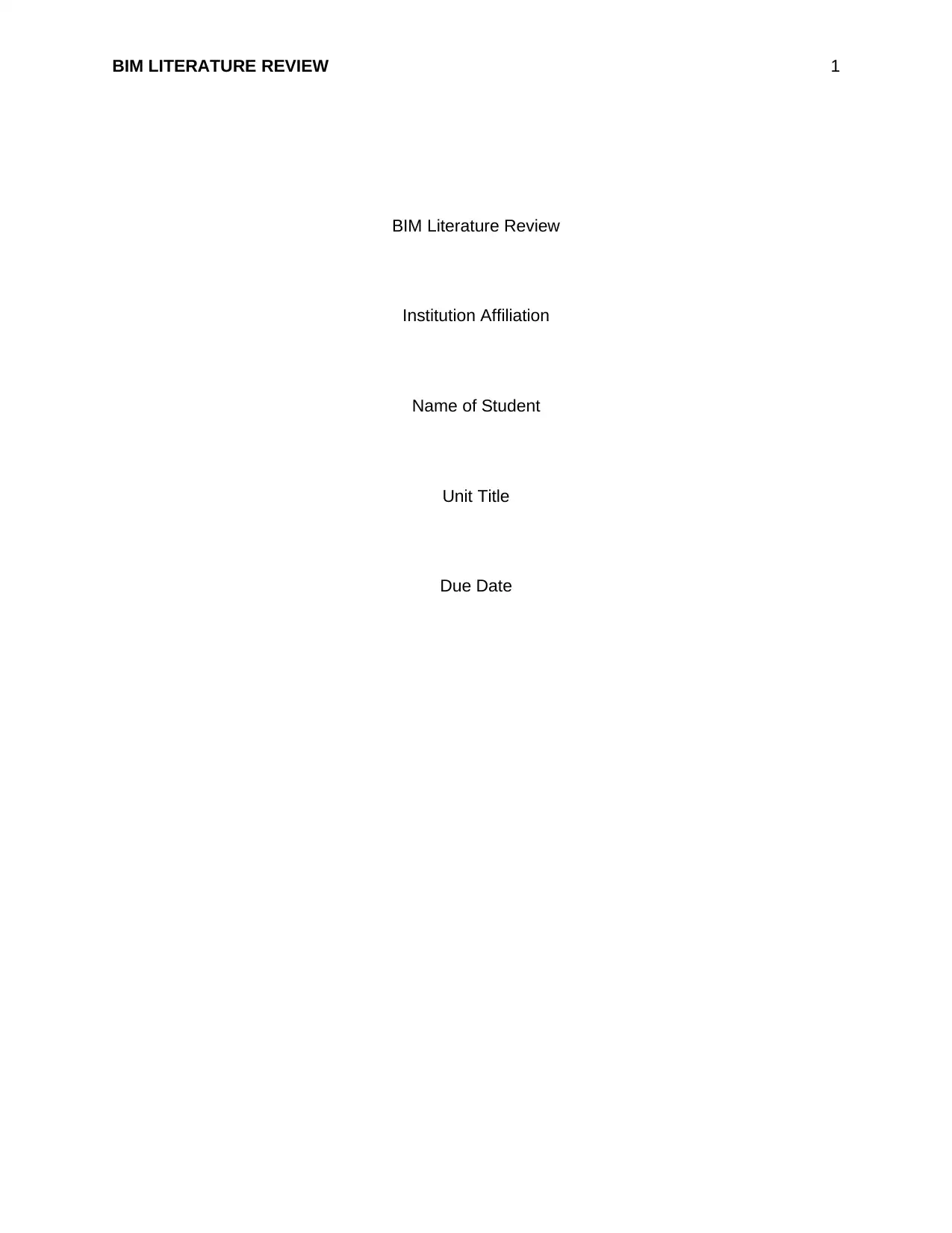
BIM LITERATURE REVIEW 1
BIM Literature Review
Institution Affiliation
Name of Student
Unit Title
Due Date
BIM Literature Review
Institution Affiliation
Name of Student
Unit Title
Due Date
Paraphrase This Document
Need a fresh take? Get an instant paraphrase of this document with our AI Paraphraser
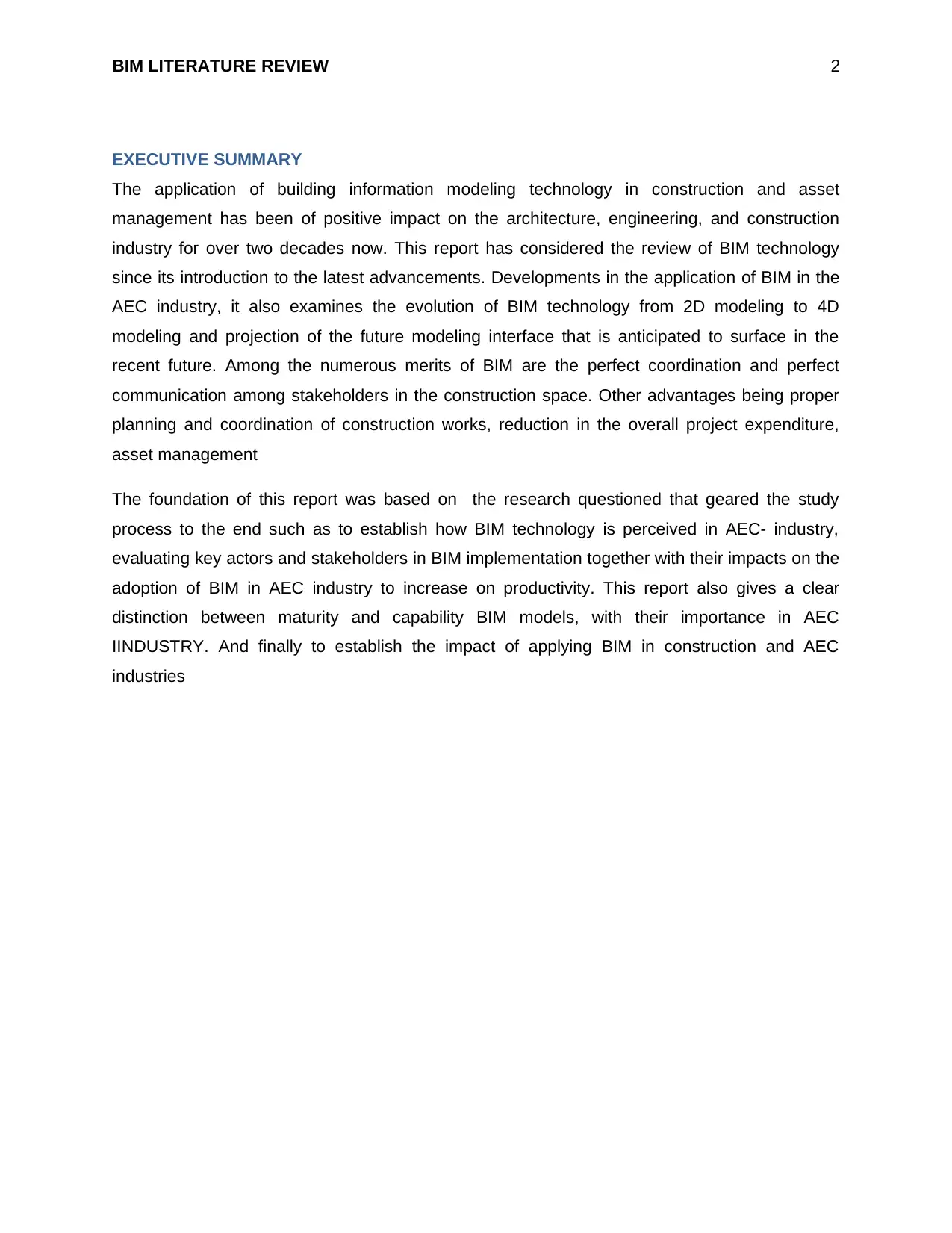
BIM LITERATURE REVIEW 2
EXECUTIVE SUMMARY
The application of building information modeling technology in construction and asset
management has been of positive impact on the architecture, engineering, and construction
industry for over two decades now. This report has considered the review of BIM technology
since its introduction to the latest advancements. Developments in the application of BIM in the
AEC industry, it also examines the evolution of BIM technology from 2D modeling to 4D
modeling and projection of the future modeling interface that is anticipated to surface in the
recent future. Among the numerous merits of BIM are the perfect coordination and perfect
communication among stakeholders in the construction space. Other advantages being proper
planning and coordination of construction works, reduction in the overall project expenditure,
asset management
The foundation of this report was based on the research questioned that geared the study
process to the end such as to establish how BIM technology is perceived in AEC- industry,
evaluating key actors and stakeholders in BIM implementation together with their impacts on the
adoption of BIM in AEC industry to increase on productivity. This report also gives a clear
distinction between maturity and capability BIM models, with their importance in AEC
IINDUSTRY. And finally to establish the impact of applying BIM in construction and AEC
industries
EXECUTIVE SUMMARY
The application of building information modeling technology in construction and asset
management has been of positive impact on the architecture, engineering, and construction
industry for over two decades now. This report has considered the review of BIM technology
since its introduction to the latest advancements. Developments in the application of BIM in the
AEC industry, it also examines the evolution of BIM technology from 2D modeling to 4D
modeling and projection of the future modeling interface that is anticipated to surface in the
recent future. Among the numerous merits of BIM are the perfect coordination and perfect
communication among stakeholders in the construction space. Other advantages being proper
planning and coordination of construction works, reduction in the overall project expenditure,
asset management
The foundation of this report was based on the research questioned that geared the study
process to the end such as to establish how BIM technology is perceived in AEC- industry,
evaluating key actors and stakeholders in BIM implementation together with their impacts on the
adoption of BIM in AEC industry to increase on productivity. This report also gives a clear
distinction between maturity and capability BIM models, with their importance in AEC
IINDUSTRY. And finally to establish the impact of applying BIM in construction and AEC
industries
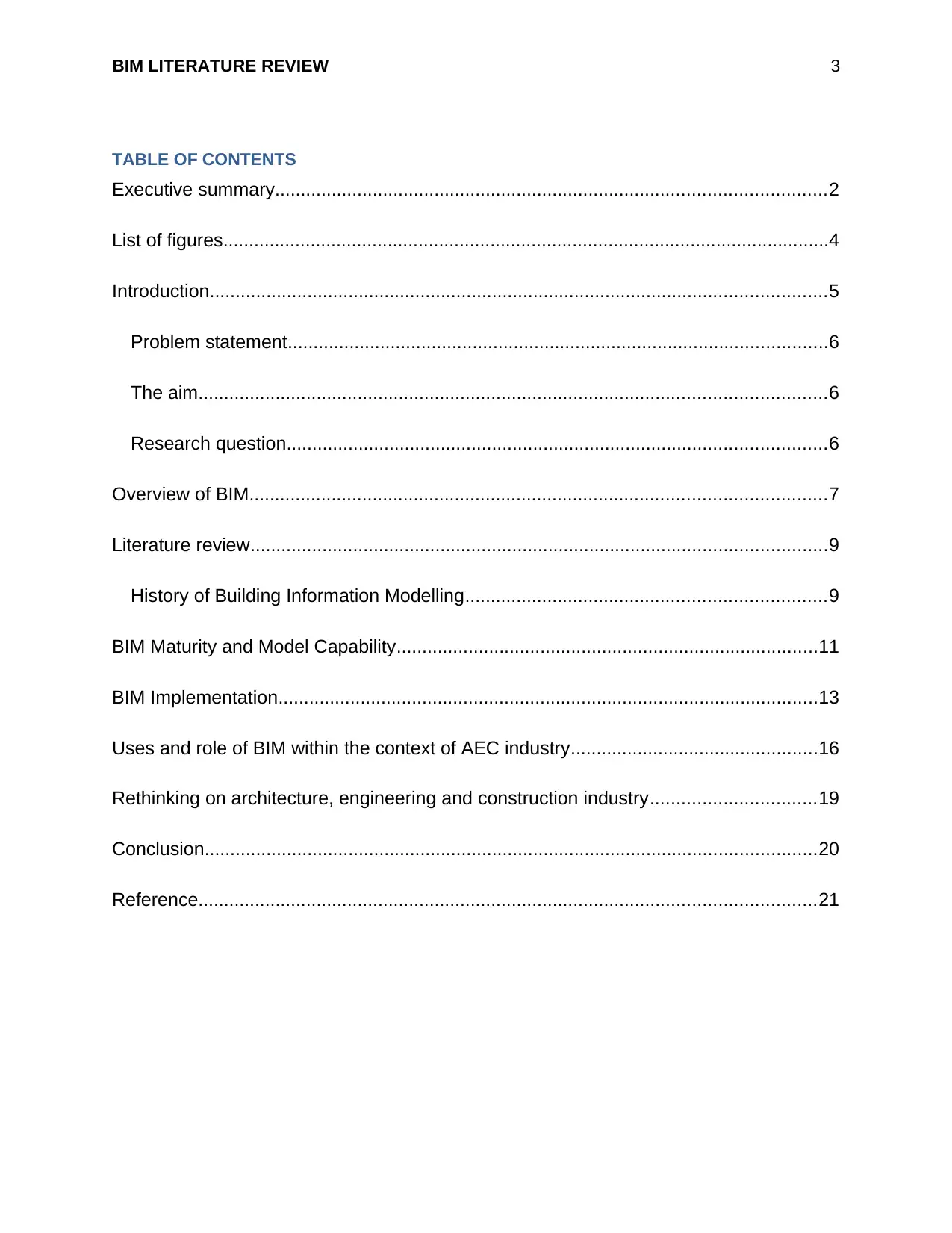
BIM LITERATURE REVIEW 3
TABLE OF CONTENTS
Executive summary...........................................................................................................2
List of figures......................................................................................................................4
Introduction........................................................................................................................5
Problem statement.........................................................................................................6
The aim..........................................................................................................................6
Research question.........................................................................................................6
Overview of BIM................................................................................................................7
Literature review................................................................................................................9
History of Building Information Modelling......................................................................9
BIM Maturity and Model Capability..................................................................................11
BIM Implementation.........................................................................................................13
Uses and role of BIM within the context of AEC industry................................................16
Rethinking on architecture, engineering and construction industry................................19
Conclusion.......................................................................................................................20
Reference........................................................................................................................21
TABLE OF CONTENTS
Executive summary...........................................................................................................2
List of figures......................................................................................................................4
Introduction........................................................................................................................5
Problem statement.........................................................................................................6
The aim..........................................................................................................................6
Research question.........................................................................................................6
Overview of BIM................................................................................................................7
Literature review................................................................................................................9
History of Building Information Modelling......................................................................9
BIM Maturity and Model Capability..................................................................................11
BIM Implementation.........................................................................................................13
Uses and role of BIM within the context of AEC industry................................................16
Rethinking on architecture, engineering and construction industry................................19
Conclusion.......................................................................................................................20
Reference........................................................................................................................21
⊘ This is a preview!⊘
Do you want full access?
Subscribe today to unlock all pages.

Trusted by 1+ million students worldwide
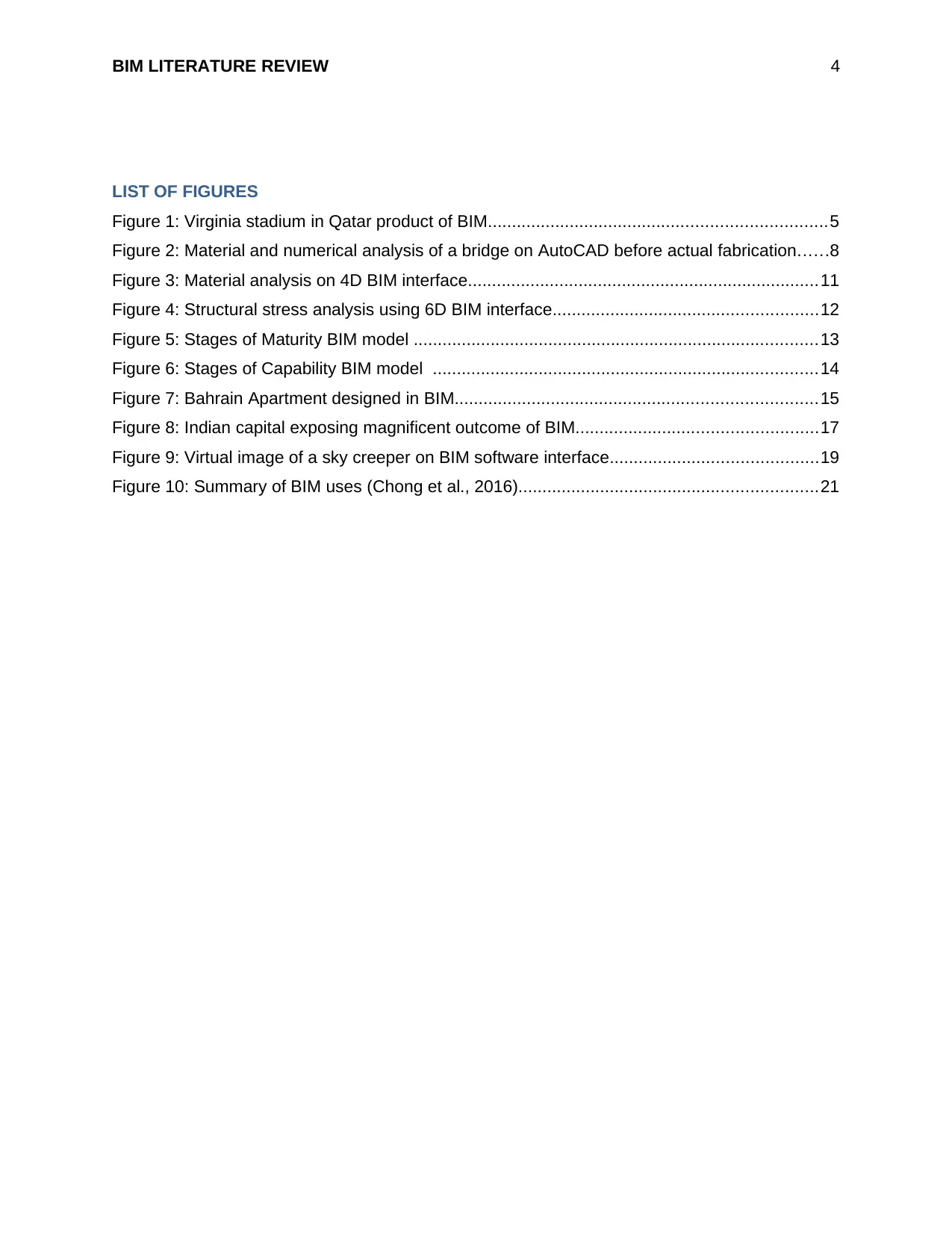
BIM LITERATURE REVIEW 4
LIST OF FIGURES
Figure 1: Virginia stadium in Qatar product of BIM......................................................................5
Figure 2: Material and numerical analysis of a bridge on AutoCAD before actual fabrication......8
Figure 3: Material analysis on 4D BIM interface.........................................................................11
Figure 4: Structural stress analysis using 6D BIM interface.......................................................12
Figure 5: Stages of Maturity BIM model ....................................................................................13
Figure 6: Stages of Capability BIM model ................................................................................14
Figure 7: Bahrain Apartment designed in BIM...........................................................................15
Figure 8: Indian capital exposing magnificent outcome of BIM..................................................17
Figure 9: Virtual image of a sky creeper on BIM software interface...........................................19
Figure 10: Summary of BIM uses (Chong et al., 2016)..............................................................21
LIST OF FIGURES
Figure 1: Virginia stadium in Qatar product of BIM......................................................................5
Figure 2: Material and numerical analysis of a bridge on AutoCAD before actual fabrication......8
Figure 3: Material analysis on 4D BIM interface.........................................................................11
Figure 4: Structural stress analysis using 6D BIM interface.......................................................12
Figure 5: Stages of Maturity BIM model ....................................................................................13
Figure 6: Stages of Capability BIM model ................................................................................14
Figure 7: Bahrain Apartment designed in BIM...........................................................................15
Figure 8: Indian capital exposing magnificent outcome of BIM..................................................17
Figure 9: Virtual image of a sky creeper on BIM software interface...........................................19
Figure 10: Summary of BIM uses (Chong et al., 2016)..............................................................21
Paraphrase This Document
Need a fresh take? Get an instant paraphrase of this document with our AI Paraphraser
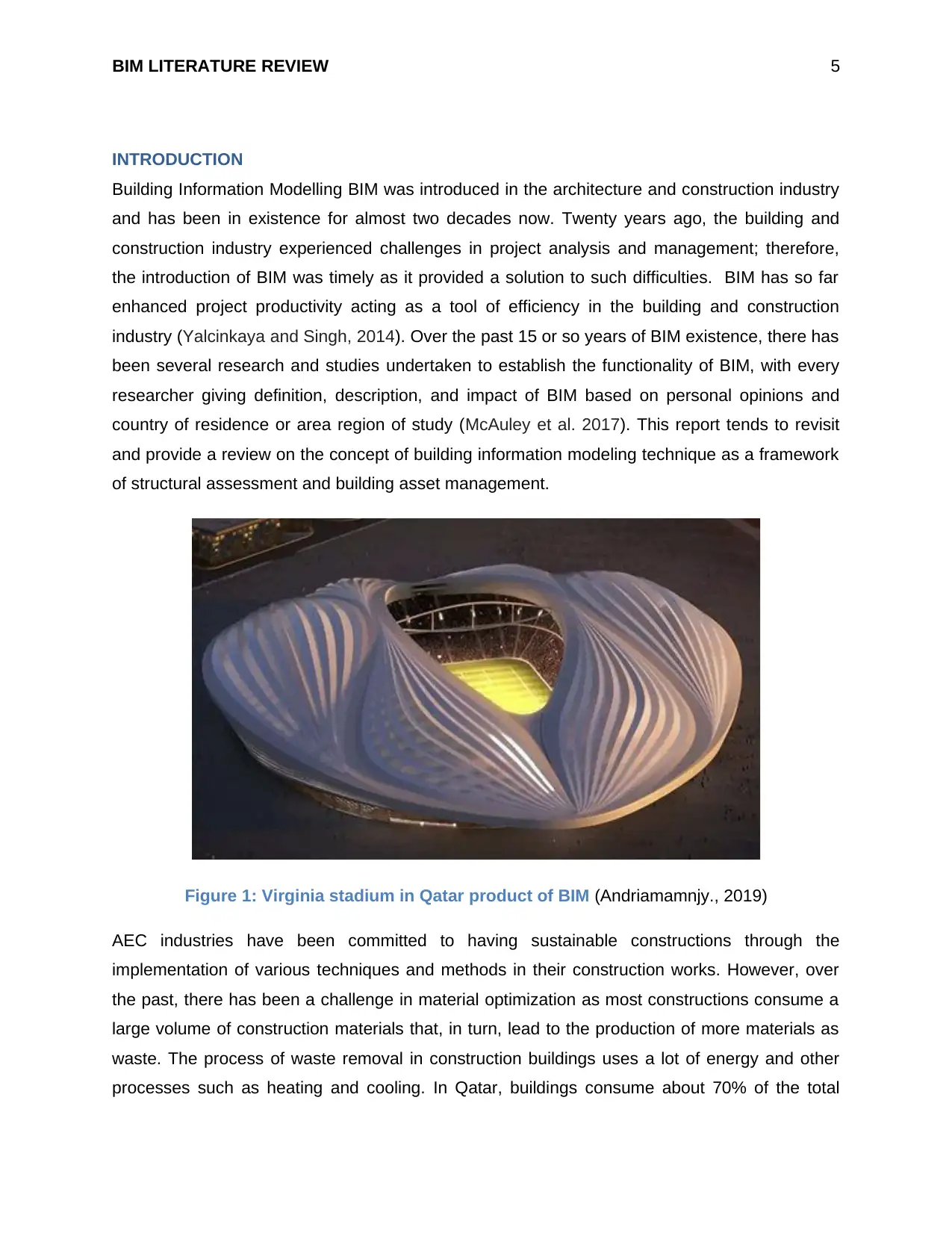
BIM LITERATURE REVIEW 5
INTRODUCTION
Building Information Modelling BIM was introduced in the architecture and construction industry
and has been in existence for almost two decades now. Twenty years ago, the building and
construction industry experienced challenges in project analysis and management; therefore,
the introduction of BIM was timely as it provided a solution to such difficulties. BIM has so far
enhanced project productivity acting as a tool of efficiency in the building and construction
industry (Yalcinkaya and Singh, 2014). Over the past 15 or so years of BIM existence, there has
been several research and studies undertaken to establish the functionality of BIM, with every
researcher giving definition, description, and impact of BIM based on personal opinions and
country of residence or area region of study (McAuley et al. 2017). This report tends to revisit
and provide a review on the concept of building information modeling technique as a framework
of structural assessment and building asset management.
Figure 1: Virginia stadium in Qatar product of BIM (Andriamamnjy., 2019)
AEC industries have been committed to having sustainable constructions through the
implementation of various techniques and methods in their construction works. However, over
the past, there has been a challenge in material optimization as most constructions consume a
large volume of construction materials that, in turn, lead to the production of more materials as
waste. The process of waste removal in construction buildings uses a lot of energy and other
processes such as heating and cooling. In Qatar, buildings consume about 70% of the total
INTRODUCTION
Building Information Modelling BIM was introduced in the architecture and construction industry
and has been in existence for almost two decades now. Twenty years ago, the building and
construction industry experienced challenges in project analysis and management; therefore,
the introduction of BIM was timely as it provided a solution to such difficulties. BIM has so far
enhanced project productivity acting as a tool of efficiency in the building and construction
industry (Yalcinkaya and Singh, 2014). Over the past 15 or so years of BIM existence, there has
been several research and studies undertaken to establish the functionality of BIM, with every
researcher giving definition, description, and impact of BIM based on personal opinions and
country of residence or area region of study (McAuley et al. 2017). This report tends to revisit
and provide a review on the concept of building information modeling technique as a framework
of structural assessment and building asset management.
Figure 1: Virginia stadium in Qatar product of BIM (Andriamamnjy., 2019)
AEC industries have been committed to having sustainable constructions through the
implementation of various techniques and methods in their construction works. However, over
the past, there has been a challenge in material optimization as most constructions consume a
large volume of construction materials that, in turn, lead to the production of more materials as
waste. The process of waste removal in construction buildings uses a lot of energy and other
processes such as heating and cooling. In Qatar, buildings consume about 70% of the total
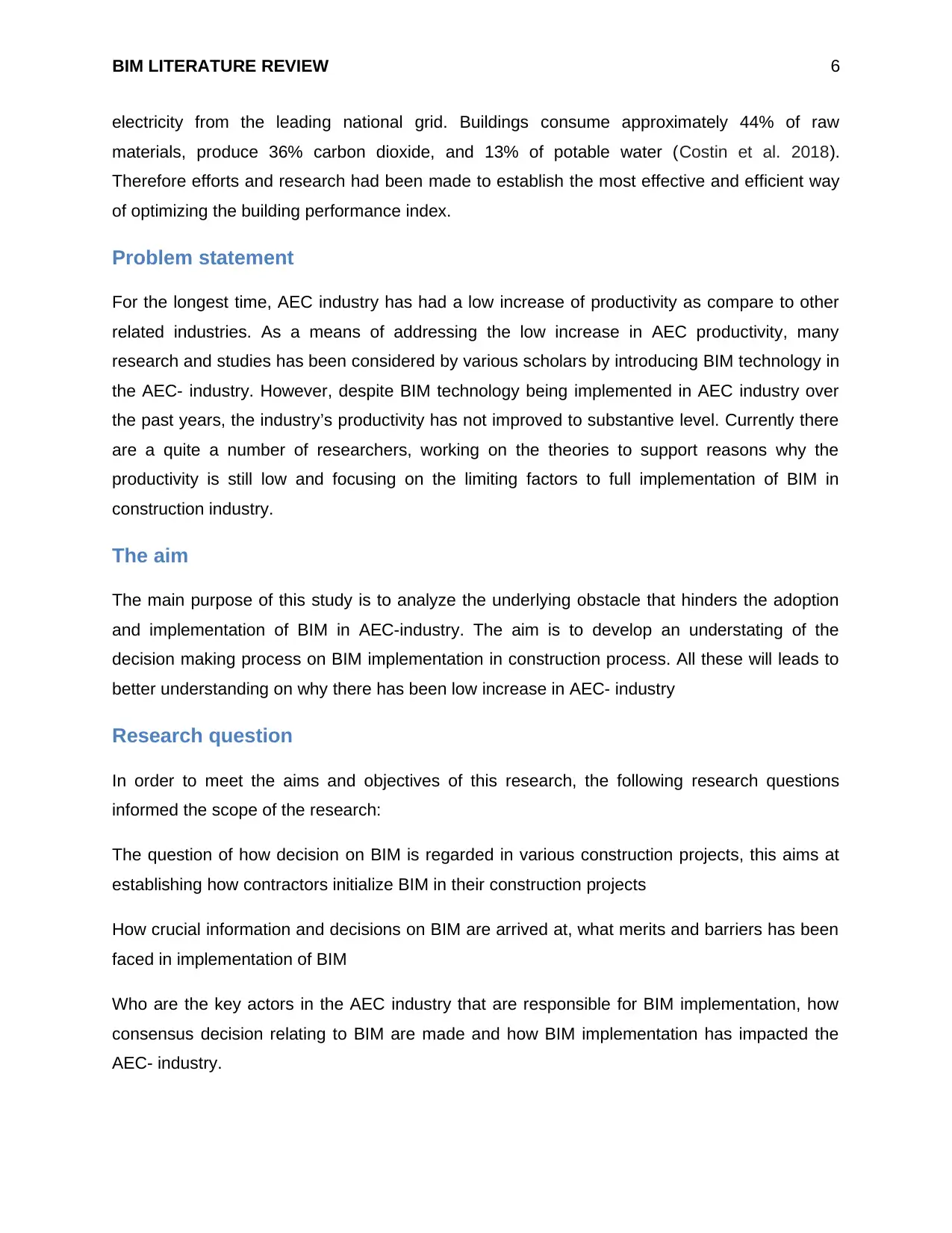
BIM LITERATURE REVIEW 6
electricity from the leading national grid. Buildings consume approximately 44% of raw
materials, produce 36% carbon dioxide, and 13% of potable water (Costin et al. 2018).
Therefore efforts and research had been made to establish the most effective and efficient way
of optimizing the building performance index.
Problem statement
For the longest time, AEC industry has had a low increase of productivity as compare to other
related industries. As a means of addressing the low increase in AEC productivity, many
research and studies has been considered by various scholars by introducing BIM technology in
the AEC- industry. However, despite BIM technology being implemented in AEC industry over
the past years, the industry’s productivity has not improved to substantive level. Currently there
are a quite a number of researchers, working on the theories to support reasons why the
productivity is still low and focusing on the limiting factors to full implementation of BIM in
construction industry.
The aim
The main purpose of this study is to analyze the underlying obstacle that hinders the adoption
and implementation of BIM in AEC-industry. The aim is to develop an understating of the
decision making process on BIM implementation in construction process. All these will leads to
better understanding on why there has been low increase in AEC- industry
Research question
In order to meet the aims and objectives of this research, the following research questions
informed the scope of the research:
The question of how decision on BIM is regarded in various construction projects, this aims at
establishing how contractors initialize BIM in their construction projects
How crucial information and decisions on BIM are arrived at, what merits and barriers has been
faced in implementation of BIM
Who are the key actors in the AEC industry that are responsible for BIM implementation, how
consensus decision relating to BIM are made and how BIM implementation has impacted the
AEC- industry.
electricity from the leading national grid. Buildings consume approximately 44% of raw
materials, produce 36% carbon dioxide, and 13% of potable water (Costin et al. 2018).
Therefore efforts and research had been made to establish the most effective and efficient way
of optimizing the building performance index.
Problem statement
For the longest time, AEC industry has had a low increase of productivity as compare to other
related industries. As a means of addressing the low increase in AEC productivity, many
research and studies has been considered by various scholars by introducing BIM technology in
the AEC- industry. However, despite BIM technology being implemented in AEC industry over
the past years, the industry’s productivity has not improved to substantive level. Currently there
are a quite a number of researchers, working on the theories to support reasons why the
productivity is still low and focusing on the limiting factors to full implementation of BIM in
construction industry.
The aim
The main purpose of this study is to analyze the underlying obstacle that hinders the adoption
and implementation of BIM in AEC-industry. The aim is to develop an understating of the
decision making process on BIM implementation in construction process. All these will leads to
better understanding on why there has been low increase in AEC- industry
Research question
In order to meet the aims and objectives of this research, the following research questions
informed the scope of the research:
The question of how decision on BIM is regarded in various construction projects, this aims at
establishing how contractors initialize BIM in their construction projects
How crucial information and decisions on BIM are arrived at, what merits and barriers has been
faced in implementation of BIM
Who are the key actors in the AEC industry that are responsible for BIM implementation, how
consensus decision relating to BIM are made and how BIM implementation has impacted the
AEC- industry.
⊘ This is a preview!⊘
Do you want full access?
Subscribe today to unlock all pages.

Trusted by 1+ million students worldwide
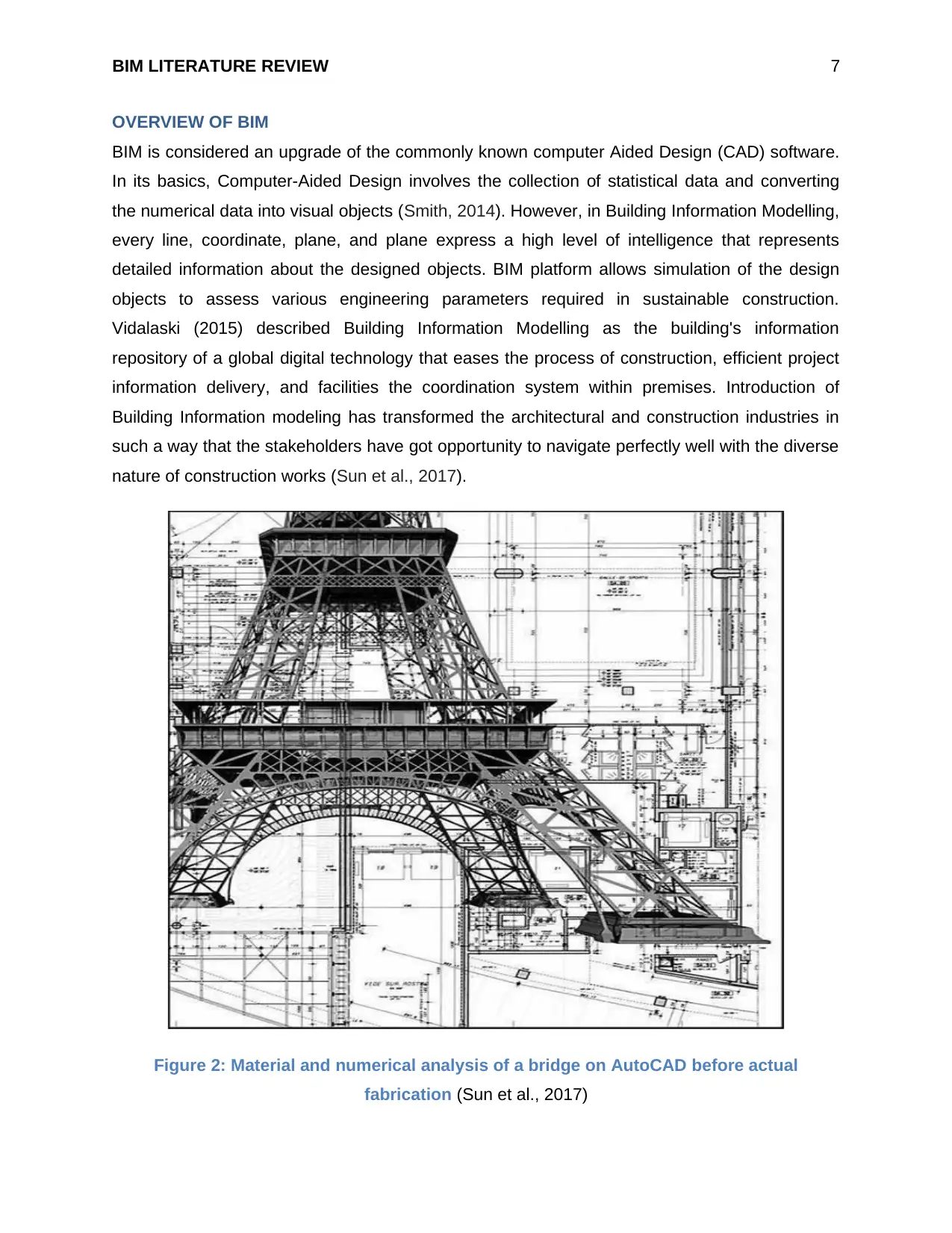
BIM LITERATURE REVIEW 7
OVERVIEW OF BIM
BIM is considered an upgrade of the commonly known computer Aided Design (CAD) software.
In its basics, Computer-Aided Design involves the collection of statistical data and converting
the numerical data into visual objects (Smith, 2014). However, in Building Information Modelling,
every line, coordinate, plane, and plane express a high level of intelligence that represents
detailed information about the designed objects. BIM platform allows simulation of the design
objects to assess various engineering parameters required in sustainable construction.
Vidalaski (2015) described Building Information Modelling as the building's information
repository of a global digital technology that eases the process of construction, efficient project
information delivery, and facilities the coordination system within premises. Introduction of
Building Information modeling has transformed the architectural and construction industries in
such a way that the stakeholders have got opportunity to navigate perfectly well with the diverse
nature of construction works (Sun et al., 2017).
Figure 2: Material and numerical analysis of a bridge on AutoCAD before actual
fabrication (Sun et al., 2017)
OVERVIEW OF BIM
BIM is considered an upgrade of the commonly known computer Aided Design (CAD) software.
In its basics, Computer-Aided Design involves the collection of statistical data and converting
the numerical data into visual objects (Smith, 2014). However, in Building Information Modelling,
every line, coordinate, plane, and plane express a high level of intelligence that represents
detailed information about the designed objects. BIM platform allows simulation of the design
objects to assess various engineering parameters required in sustainable construction.
Vidalaski (2015) described Building Information Modelling as the building's information
repository of a global digital technology that eases the process of construction, efficient project
information delivery, and facilities the coordination system within premises. Introduction of
Building Information modeling has transformed the architectural and construction industries in
such a way that the stakeholders have got opportunity to navigate perfectly well with the diverse
nature of construction works (Sun et al., 2017).
Figure 2: Material and numerical analysis of a bridge on AutoCAD before actual
fabrication (Sun et al., 2017)
Paraphrase This Document
Need a fresh take? Get an instant paraphrase of this document with our AI Paraphraser
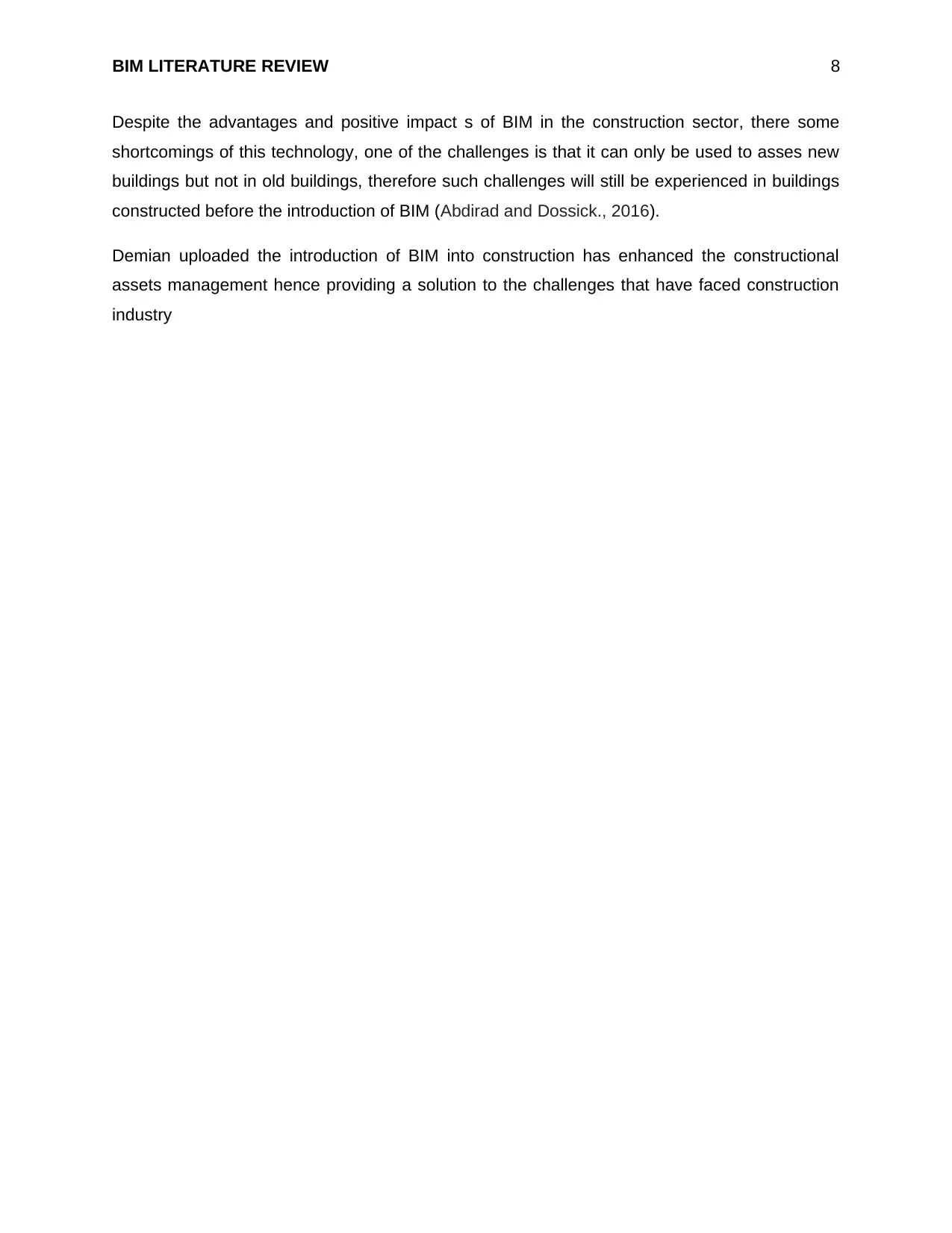
BIM LITERATURE REVIEW 8
Despite the advantages and positive impact s of BIM in the construction sector, there some
shortcomings of this technology, one of the challenges is that it can only be used to asses new
buildings but not in old buildings, therefore such challenges will still be experienced in buildings
constructed before the introduction of BIM (Abdirad and Dossick., 2016).
Demian uploaded the introduction of BIM into construction has enhanced the constructional
assets management hence providing a solution to the challenges that have faced construction
industry
Despite the advantages and positive impact s of BIM in the construction sector, there some
shortcomings of this technology, one of the challenges is that it can only be used to asses new
buildings but not in old buildings, therefore such challenges will still be experienced in buildings
constructed before the introduction of BIM (Abdirad and Dossick., 2016).
Demian uploaded the introduction of BIM into construction has enhanced the constructional
assets management hence providing a solution to the challenges that have faced construction
industry
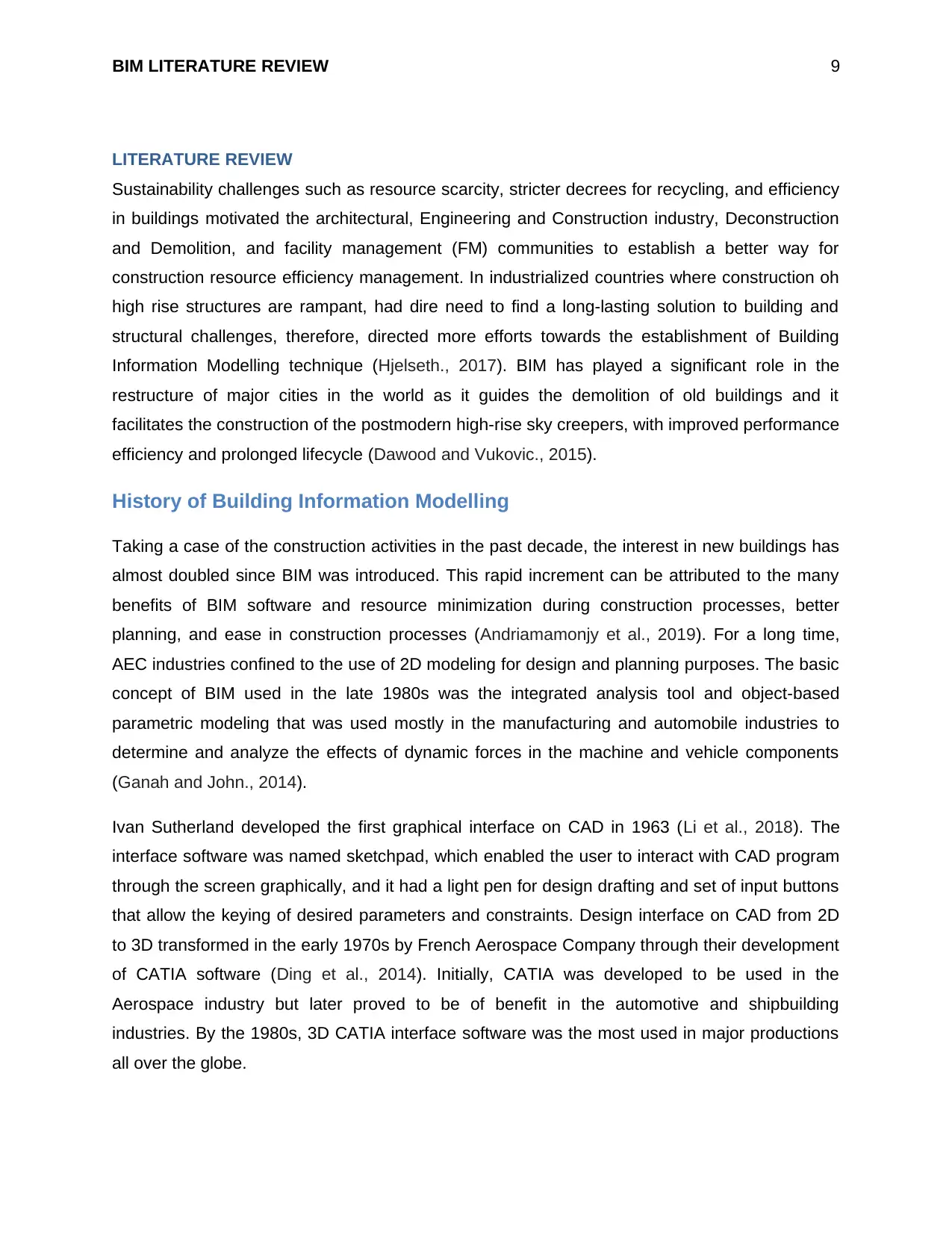
BIM LITERATURE REVIEW 9
LITERATURE REVIEW
Sustainability challenges such as resource scarcity, stricter decrees for recycling, and efficiency
in buildings motivated the architectural, Engineering and Construction industry, Deconstruction
and Demolition, and facility management (FM) communities to establish a better way for
construction resource efficiency management. In industrialized countries where construction oh
high rise structures are rampant, had dire need to find a long-lasting solution to building and
structural challenges, therefore, directed more efforts towards the establishment of Building
Information Modelling technique (Hjelseth., 2017). BIM has played a significant role in the
restructure of major cities in the world as it guides the demolition of old buildings and it
facilitates the construction of the postmodern high-rise sky creepers, with improved performance
efficiency and prolonged lifecycle (Dawood and Vukovic., 2015).
History of Building Information Modelling
Taking a case of the construction activities in the past decade, the interest in new buildings has
almost doubled since BIM was introduced. This rapid increment can be attributed to the many
benefits of BIM software and resource minimization during construction processes, better
planning, and ease in construction processes (Andriamamonjy et al., 2019). For a long time,
AEC industries confined to the use of 2D modeling for design and planning purposes. The basic
concept of BIM used in the late 1980s was the integrated analysis tool and object-based
parametric modeling that was used mostly in the manufacturing and automobile industries to
determine and analyze the effects of dynamic forces in the machine and vehicle components
(Ganah and John., 2014).
Ivan Sutherland developed the first graphical interface on CAD in 1963 (Li et al., 2018). The
interface software was named sketchpad, which enabled the user to interact with CAD program
through the screen graphically, and it had a light pen for design drafting and set of input buttons
that allow the keying of desired parameters and constraints. Design interface on CAD from 2D
to 3D transformed in the early 1970s by French Aerospace Company through their development
of CATIA software (Ding et al., 2014). Initially, CATIA was developed to be used in the
Aerospace industry but later proved to be of benefit in the automotive and shipbuilding
industries. By the 1980s, 3D CATIA interface software was the most used in major productions
all over the globe.
LITERATURE REVIEW
Sustainability challenges such as resource scarcity, stricter decrees for recycling, and efficiency
in buildings motivated the architectural, Engineering and Construction industry, Deconstruction
and Demolition, and facility management (FM) communities to establish a better way for
construction resource efficiency management. In industrialized countries where construction oh
high rise structures are rampant, had dire need to find a long-lasting solution to building and
structural challenges, therefore, directed more efforts towards the establishment of Building
Information Modelling technique (Hjelseth., 2017). BIM has played a significant role in the
restructure of major cities in the world as it guides the demolition of old buildings and it
facilitates the construction of the postmodern high-rise sky creepers, with improved performance
efficiency and prolonged lifecycle (Dawood and Vukovic., 2015).
History of Building Information Modelling
Taking a case of the construction activities in the past decade, the interest in new buildings has
almost doubled since BIM was introduced. This rapid increment can be attributed to the many
benefits of BIM software and resource minimization during construction processes, better
planning, and ease in construction processes (Andriamamonjy et al., 2019). For a long time,
AEC industries confined to the use of 2D modeling for design and planning purposes. The basic
concept of BIM used in the late 1980s was the integrated analysis tool and object-based
parametric modeling that was used mostly in the manufacturing and automobile industries to
determine and analyze the effects of dynamic forces in the machine and vehicle components
(Ganah and John., 2014).
Ivan Sutherland developed the first graphical interface on CAD in 1963 (Li et al., 2018). The
interface software was named sketchpad, which enabled the user to interact with CAD program
through the screen graphically, and it had a light pen for design drafting and set of input buttons
that allow the keying of desired parameters and constraints. Design interface on CAD from 2D
to 3D transformed in the early 1970s by French Aerospace Company through their development
of CATIA software (Ding et al., 2014). Initially, CATIA was developed to be used in the
Aerospace industry but later proved to be of benefit in the automotive and shipbuilding
industries. By the 1980s, 3D CATIA interface software was the most used in major productions
all over the globe.
⊘ This is a preview!⊘
Do you want full access?
Subscribe today to unlock all pages.

Trusted by 1+ million students worldwide
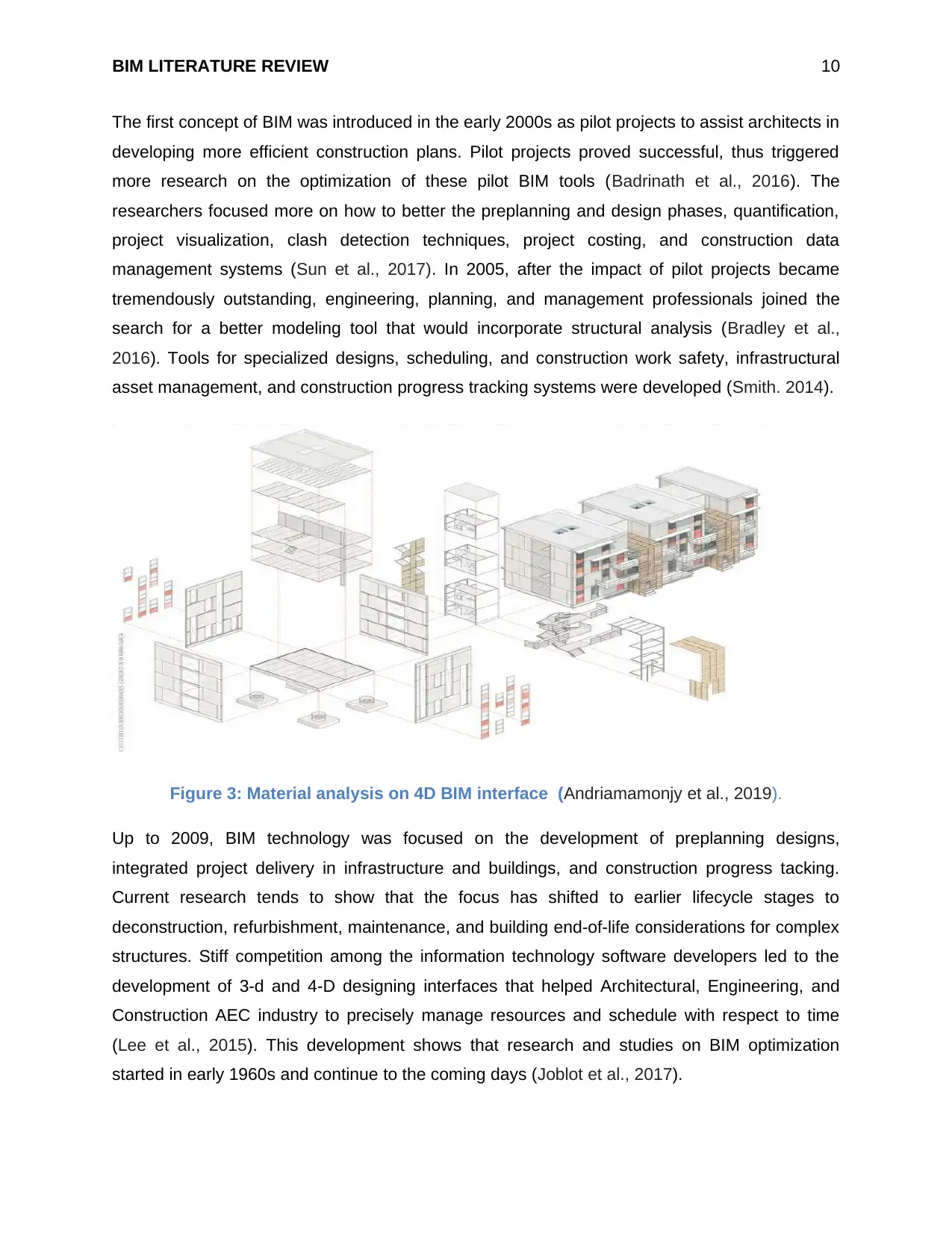
BIM LITERATURE REVIEW 10
The first concept of BIM was introduced in the early 2000s as pilot projects to assist architects in
developing more efficient construction plans. Pilot projects proved successful, thus triggered
more research on the optimization of these pilot BIM tools (Badrinath et al., 2016). The
researchers focused more on how to better the preplanning and design phases, quantification,
project visualization, clash detection techniques, project costing, and construction data
management systems (Sun et al., 2017). In 2005, after the impact of pilot projects became
tremendously outstanding, engineering, planning, and management professionals joined the
search for a better modeling tool that would incorporate structural analysis (Bradley et al.,
2016). Tools for specialized designs, scheduling, and construction work safety, infrastructural
asset management, and construction progress tracking systems were developed (Smith. 2014).
Figure 3: Material analysis on 4D BIM interface (Andriamamonjy et al., 2019).
Up to 2009, BIM technology was focused on the development of preplanning designs,
integrated project delivery in infrastructure and buildings, and construction progress tacking.
Current research tends to show that the focus has shifted to earlier lifecycle stages to
deconstruction, refurbishment, maintenance, and building end-of-life considerations for complex
structures. Stiff competition among the information technology software developers led to the
development of 3-d and 4-D designing interfaces that helped Architectural, Engineering, and
Construction AEC industry to precisely manage resources and schedule with respect to time
(Lee et al., 2015). This development shows that research and studies on BIM optimization
started in early 1960s and continue to the coming days (Joblot et al., 2017).
The first concept of BIM was introduced in the early 2000s as pilot projects to assist architects in
developing more efficient construction plans. Pilot projects proved successful, thus triggered
more research on the optimization of these pilot BIM tools (Badrinath et al., 2016). The
researchers focused more on how to better the preplanning and design phases, quantification,
project visualization, clash detection techniques, project costing, and construction data
management systems (Sun et al., 2017). In 2005, after the impact of pilot projects became
tremendously outstanding, engineering, planning, and management professionals joined the
search for a better modeling tool that would incorporate structural analysis (Bradley et al.,
2016). Tools for specialized designs, scheduling, and construction work safety, infrastructural
asset management, and construction progress tracking systems were developed (Smith. 2014).
Figure 3: Material analysis on 4D BIM interface (Andriamamonjy et al., 2019).
Up to 2009, BIM technology was focused on the development of preplanning designs,
integrated project delivery in infrastructure and buildings, and construction progress tacking.
Current research tends to show that the focus has shifted to earlier lifecycle stages to
deconstruction, refurbishment, maintenance, and building end-of-life considerations for complex
structures. Stiff competition among the information technology software developers led to the
development of 3-d and 4-D designing interfaces that helped Architectural, Engineering, and
Construction AEC industry to precisely manage resources and schedule with respect to time
(Lee et al., 2015). This development shows that research and studies on BIM optimization
started in early 1960s and continue to the coming days (Joblot et al., 2017).
Paraphrase This Document
Need a fresh take? Get an instant paraphrase of this document with our AI Paraphraser
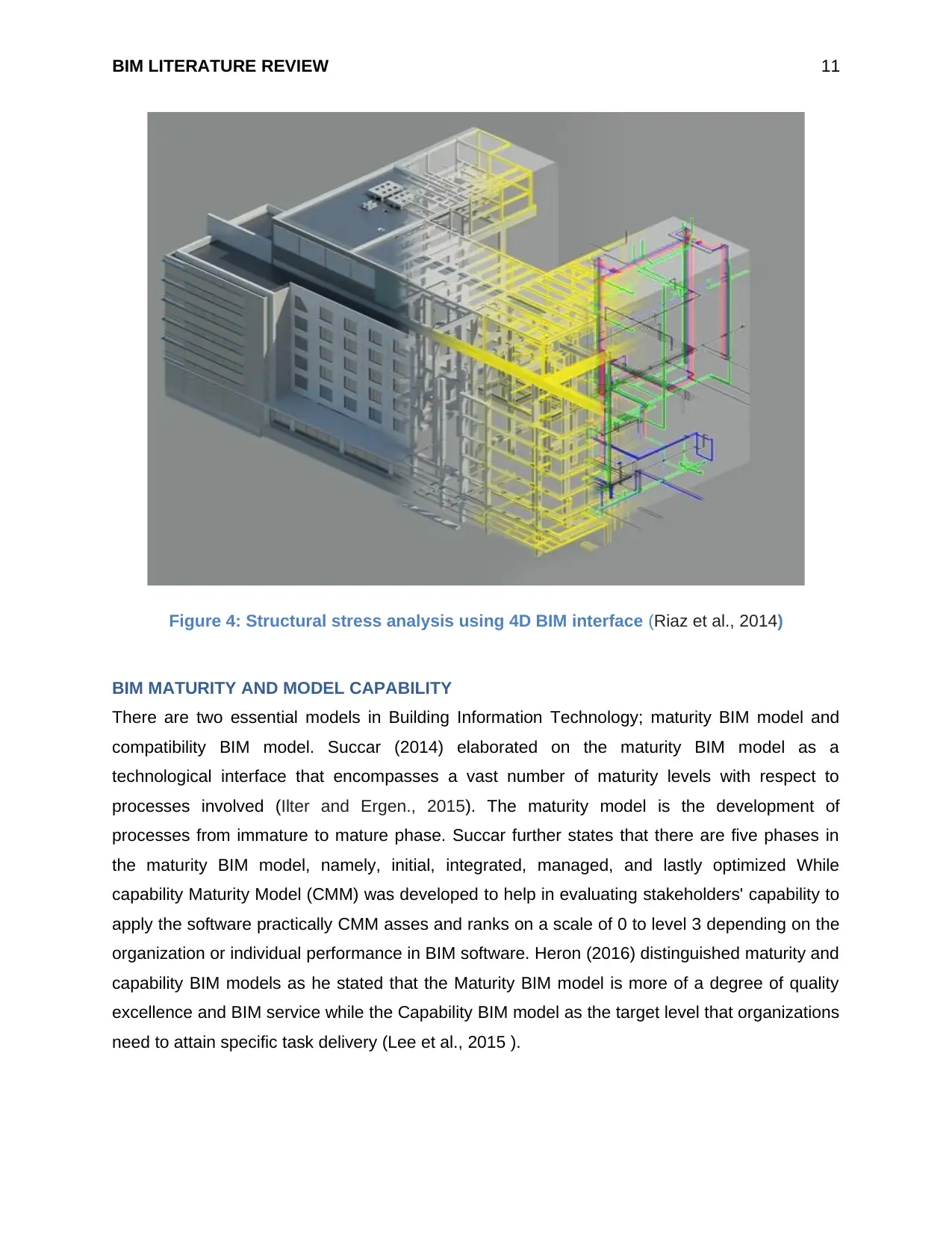
BIM LITERATURE REVIEW 11
Figure 4: Structural stress analysis using 4D BIM interface (Riaz et al., 2014)
BIM MATURITY AND MODEL CAPABILITY
There are two essential models in Building Information Technology; maturity BIM model and
compatibility BIM model. Succar (2014) elaborated on the maturity BIM model as a
technological interface that encompasses a vast number of maturity levels with respect to
processes involved (Ilter and Ergen., 2015). The maturity model is the development of
processes from immature to mature phase. Succar further states that there are five phases in
the maturity BIM model, namely, initial, integrated, managed, and lastly optimized While
capability Maturity Model (CMM) was developed to help in evaluating stakeholders' capability to
apply the software practically CMM asses and ranks on a scale of 0 to level 3 depending on the
organization or individual performance in BIM software. Heron (2016) distinguished maturity and
capability BIM models as he stated that the Maturity BIM model is more of a degree of quality
excellence and BIM service while the Capability BIM model as the target level that organizations
need to attain specific task delivery (Lee et al., 2015 ).
Figure 4: Structural stress analysis using 4D BIM interface (Riaz et al., 2014)
BIM MATURITY AND MODEL CAPABILITY
There are two essential models in Building Information Technology; maturity BIM model and
compatibility BIM model. Succar (2014) elaborated on the maturity BIM model as a
technological interface that encompasses a vast number of maturity levels with respect to
processes involved (Ilter and Ergen., 2015). The maturity model is the development of
processes from immature to mature phase. Succar further states that there are five phases in
the maturity BIM model, namely, initial, integrated, managed, and lastly optimized While
capability Maturity Model (CMM) was developed to help in evaluating stakeholders' capability to
apply the software practically CMM asses and ranks on a scale of 0 to level 3 depending on the
organization or individual performance in BIM software. Heron (2016) distinguished maturity and
capability BIM models as he stated that the Maturity BIM model is more of a degree of quality
excellence and BIM service while the Capability BIM model as the target level that organizations
need to attain specific task delivery (Lee et al., 2015 ).
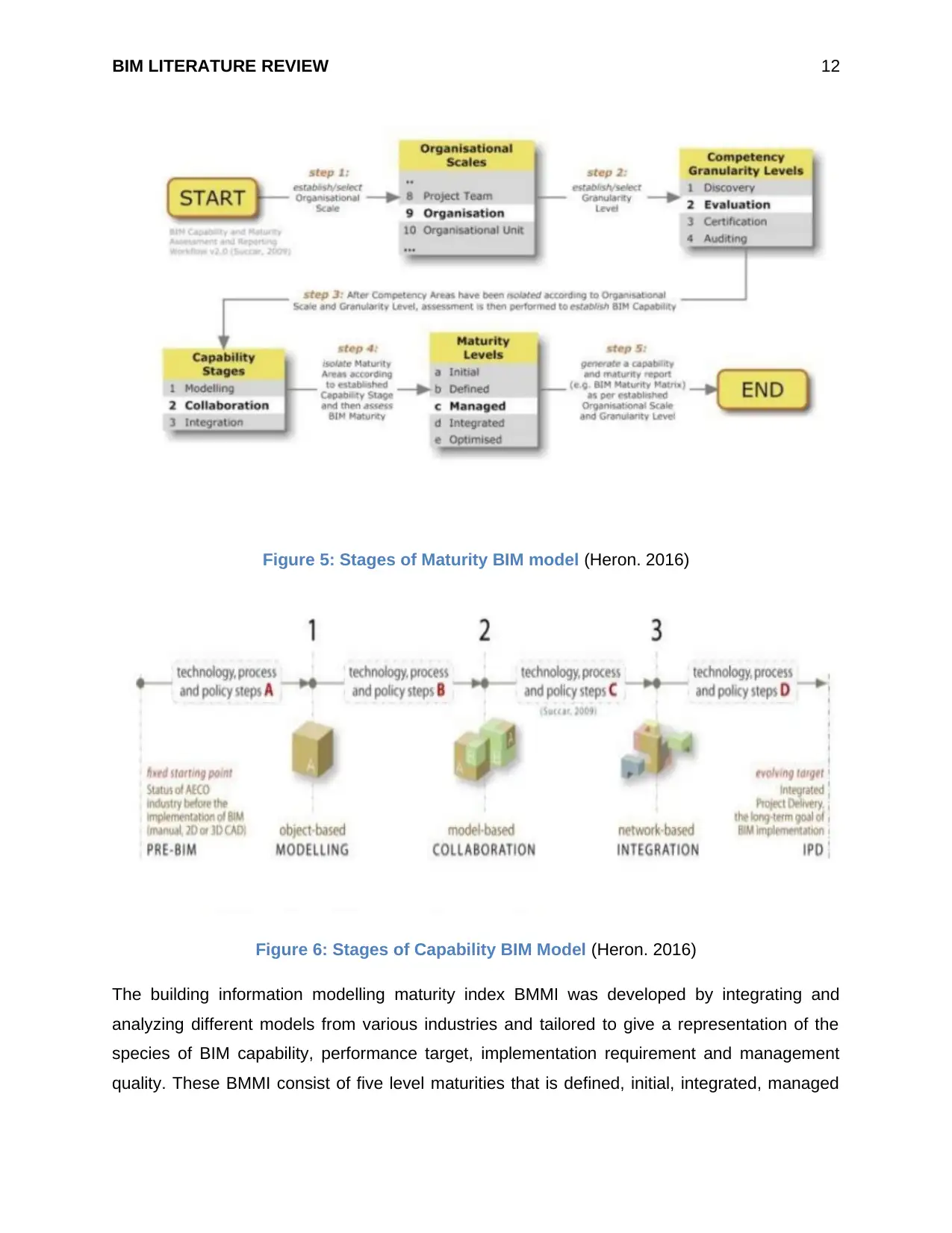
BIM LITERATURE REVIEW 12
Figure 5: Stages of Maturity BIM model (Heron. 2016)
Figure 6: Stages of Capability BIM Model (Heron. 2016)
The building information modelling maturity index BMMI was developed by integrating and
analyzing different models from various industries and tailored to give a representation of the
species of BIM capability, performance target, implementation requirement and management
quality. These BMMI consist of five level maturities that is defined, initial, integrated, managed
Figure 5: Stages of Maturity BIM model (Heron. 2016)
Figure 6: Stages of Capability BIM Model (Heron. 2016)
The building information modelling maturity index BMMI was developed by integrating and
analyzing different models from various industries and tailored to give a representation of the
species of BIM capability, performance target, implementation requirement and management
quality. These BMMI consist of five level maturities that is defined, initial, integrated, managed
⊘ This is a preview!⊘
Do you want full access?
Subscribe today to unlock all pages.

Trusted by 1+ million students worldwide
1 out of 22
Related Documents
Your All-in-One AI-Powered Toolkit for Academic Success.
+13062052269
info@desklib.com
Available 24*7 on WhatsApp / Email
![[object Object]](/_next/static/media/star-bottom.7253800d.svg)
Unlock your academic potential
Copyright © 2020–2025 A2Z Services. All Rights Reserved. Developed and managed by ZUCOL.





